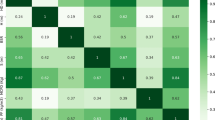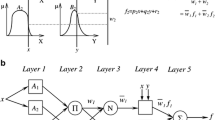Abstract
This research focuses to propose a new hybrid approach which combined the recurrent fuzzy neural network (RFNN) with particle swarm optimization (PSO) algorithm to simulate the flyrock distance induced by mine blasting. Here, this combination is abbreviated using RFNN–PSO. To evaluate the acceptability of RFNN–PSO model, adaptive neuro-fuzzy inference system (ANFIS) and non-linear regression models were also used. To achieve the objective of this research, 72 sets of data were collected from Shur river dam region, in Iran. Maximum charge per delay, stemming, burden, and spacing were considered as input parameters in the models. Then, the performance of the RFNN–PSO model was evaluated against ANFIS and non-linear regression models. Correlation coefficient (R2), Nash and Sutcliffe (NS), mean absolute bias error (MABE), and root-mean-squared error (RMSE) were used as comparing statistical indicators for the assessment of the developed approach’s performance. Results show a satisfactory achievement between the actual and predicted flyrcok values by RFNN–PSO with R2, NS, MABE, and RMSE being 0.933, 0.921, 13.86, and 15.79, respectively.










Similar content being viewed by others
References
Rezaei M, Monjezi M, Varjani AY (2011) Development of a fuzzy model to predict flyrock in surface mining. Saf Sci 49(2):298–305
Khandelwal M, Monjezi M (2013) Prediction of flyrock in open pit blasting operation using machine learning method. Int J Min Sci Technol 23:313–316
Jahed Armaghani D, Hajihassani M, Monjezi M, Mohamad ET, Marto A, Moghaddam MR (2015) Application of two intelligent systems in predicting environmental impacts of quarry blasting. Arab J Geosci. https://doi.org/10.1007/s12517-015-1908-2
Hasanipanah M, Shirani Faradonbeh R, Jahed Armaghani D, Bakhshandeh Amnieh H, Khandelwal M (2017) Development of a precise model for prediction of blast-induced flyrock using regression tree technique. Environ Earth Sci 76:27
Hasanipanah M, Armaghani DJ, Amnieh HB, Majid MZA, Tahir MMD (2017) Application of PSO to develop a powerful equation for prediction of flyrock due to blasting. Neural Comput Appl 28(1):1043–1050
Hasanipanah M, Armaghani DJ, Amnieh HB, Koopialipoor M, Arab H (2018) A risk-based technique to analyze flyrock results through rock engineering system. Geotech Geol Eng 36:2247–2260
Rad HN, Hasanipanah M, Rezaei M, Eghlim AL (2018) Developing a least squares support vector machine for estimating the blast-induced flyrock. Eng Comput 34(4):709–717
Mohammadhassani M, Nezamabadi-pour H, Shariati M, Suhatril M (2013) Identification of a suitable ANN architecture in predicting strain in tie section of concrete deep beams. Struct Eng Mech 46(6):853–868
Toghroli A, Mohammadhassani M, Shariati M, Suhatril M, Ibrahim Z, Ramli Sulong NH (2014) Prediction of shear capacity of channel shear connectors using the ANFIS model. Steel Compos Struct J 17(5):623–639
Mohammadhassani M, Nezamabadi-Pour H, Suhatril M, Shariati M (2014) An evolutionary fuzzy modelling approach and comparison of different methods for shear strength prediction of high-strength concrete beams without stirrups. Smart Struct Syst Int J 14(5):785–809
Mansouri I et al (2016) Strength prediction of rotary brace damper using MLR and MARS. Struct Eng Mech 60(3):471–488
Hasanipanah M, Noorian-Bidgoli M, Armaghani DJ, Khamesi H (2016) Feasibility of PSO-ANN model for predicting surface settlement caused by tunneling. Eng Comput 32(4):705–715
Toghroli A et al (2016) Potential of soft computing approach for evaluating the factors affecting the capacity of steel–concrete composite beam. J Intell Manuf. https://doi.org/10.1007/s10845-016-1217-y
Safa M et al (2016) Potential of adaptive neuro fuzzy inference system for evaluating the factors affecting steel-concrete composite beam’s shear strength. Steel Compos Struct 21(3):679–688
Hasanipanah M et al (2016) Prediction of an environmental issue of mine blasting: an imperialistic competitive algorithm-based fuzzy system. Int J Environ Sci Technol. https://doi.org/10.1007/s13762-017-1395-y
Mansouri I et al (2017) Analysis of influential factors for predicting the shear strength of a V-shaped angle shear connector in composite beams using an adaptive neuro-fuzzy technique. J Intell Manuf. https://doi.org/10.1007/s10845-017-1306-6
Behzadafshar K, Sarafraz ME, Hasanipanah M, Mojtahedi SFF, Tahir MM (2017) Proposing a new model to approximate the elasticity modulus of granite rock samples based on laboratory tests results. Bull Eng Geol Env. https://doi.org/10.1007/s10064-017-1210-5
Azura Sari P et al (2018) An intelligent based-model role to simulate the factor of safe slope by support vector regression. Eng Comput. https://doi.org/10.1007/s00366-018-0677-4
Sedghi Y et al (2018) Application of ANFIS technique on performance of C and L shaped angle shear connectors. Smart Struct Syst 22(3):335–340
Sadeghipour Chahnasir E et al (2018) Application of support vector machine with firefly algorithm for investigation of the factors affecting the shear strength of angle shear connectors. Smart Struct Syst 22(4):413–424
Mohamad ET, Armaghani DJ, Hasanipanah M, Murlidhar BR, Alel MNA (2016) Estimation of air-overpressure produced by blasting operation through a neuro-genetic technique. Environ Earth Sci 75(2):174
Monjezi M, Mehrdanesh A, Malek A, Khandelwal M (2013) Evaluation of effect of blast design parameters on flyrock using artificial neural networks. Neural Comput Appl 23:349–356
Amini H, Gholami R, Monjezi M, Torabi SR, Zadhesh J (2011) Evaluation of flyrock phenomenon due to blasting operation by support vector machine. Neural Comput Appl. https://doi.org/10.1007/s00521-011-0631-5
Trivedi R, Singh TN, Gupta NI (2015) Prediction of blast induced flyrock in opencast mines using ANN and ANFIS. Geotech Geol Eng 33:875–891
Amiri M, Bakhshandeh Amnieh H, Hasanipanah M, Mohammad Khanli L (2016) A new combination of artificial neural network and K-nearest neighbors models to predict blast induced ground vibration and air-overpressure. Eng Comput. https://doi.org/10.1007/s00366-016-0442-5
Hasanipanah M, Shahnazar A, Arab H, Golzar SB, Amiri M (2017) Developing a new hybrid-AI model to predict blast induced backbreak. Eng Comput 33(3):349–359
Keshtegar B, Hasanipanah M, Bakhshayeshi I, Sarafraz ME (2019) A novel nonlinear modeling for the prediction of blast induced airblast using a modified conjugate FR method. Measurement 131:35–41
Monjezi M, Hasanipanah M, Khandelwal M (2013) Evaluation and prediction of blast-induced ground vibration at Shur River Dam, Iran, by artificial neural network. Neural Comput Appl 22(7–8):1637–1643
Hasanipanah M, Amnieh HB, Arab H, Zamzam MS (2018) Feasibility of PSO–ANFIS model to estimate rock fragmentation produced by mine blasting. Neural Comput Appl 30(4):1015–1024
Aliev RA, Guirimov BG, Fazlollahi B, Aliev RR (2009) Evolutionary algorithm-based learning of fuzzy neural networks. Part 2: recurrent fuzzy neural networks. Fuzzy Sets Syst 160(17):2553–2566
Duong HN, Nguyen HT, Vaclav S, Sanghyuk L (2016) A comparative study of SWAT, RFNN and RFNN–GA for predicting river runoff. Indian J Sci Technol 9(17). https://doi.org/10.17485/ijst/2016/v9i17/92308
Duong HN, Nguyen Q, Ta Bui L, Nguyen H, Snášel V (2014) Applying Recurrent fuzzy neural network to predict the runoff of Srepok River. In: IFIP international conference on computer information systems and industrial management CISIM: computer information systems and industrial management. CISIM 2015. Lecture Notes in Computer Science, vol 8838. Springer, Berlin, Heidelberg. https://doi.org/10.1007/978-3-662-45237-0_7
Jahed Armaghani D, Tonnizam Mohamad E, Sundaram Narayanasamy M, Narita N, Yagiz S (2017) Development of hybrid intelligent models for predicting TBM penetration rate in hard rock condition. Tunn Undergr Space Technol 63:29–43
Shahnazar A, Nikafshan Rad H, Hasanipanah M, Tahir MM, Jahed Armaghani D, Ghoroqi M (2017) A new developed approach for the prediction of ground vibration using a hybrid PSO-optimized ANFIS-based model. Environ Earth Sci 76(15):527
Samui P, Kim D, Viswanathan R (2015) Spatial variability of rock depth using adaptive neuro-fuzzy inference system (ANFIS) and multivariate adaptive regression spline (MARS). Environ Earth Sci. https://doi.org/10.1007/s12665-014-3711-x
Koçaslan A, Yüksek AG, Görgülü K, Arpaz E (2017) Evaluation of blast-induced ground vibrations in open-pit mines by using adaptive neuro-fuzzy inference systems. Environ Earth Sci 76:57
Hasanipanah M, Armaghani DJ, Monjezi M, Shams S (2016) Risk assessment and prediction of rock fragmentation produced by blasting operation: a rock engineering system. Environ Earth Sci 75(9):808
Jahed Armaghani D, Hasanipanah M, Bakhshandeh Amnieh H, Mohamad ET (2016) Feasibility of ICA in approximating ground vibration resulting from mine blasting. Neural Comput Appl. https://doi.org/10.1007/s00521-016-2577-0
Taheri K, Hasanipanah M, Bagheri Golzar S, Abd Majid MZ (2016) A hybrid artificial bee colony algorithm-artificial neural network for forecasting the blast-produced ground vibration. Eng Comput 33(3):689–700
Armaghani DJ, Hasanipanah M, Mohamad ET (2016) A combination of the ICA-ANN model to predict air-overpressure resulting from blasting. Eng Comput 32(1):155–171
Hasanipanah M, Golzar SB, Larki IA, Maryaki MY, Ghahremanians T (2017) Estimation of blast-induced ground vibration through a soft computing framework. Eng Comput 33(4):951–959
Hasanipanah M, Shirani Faradonbeh R, Bakhshandeh Amnieh H, Jahed Armaghani D, Monjezi M (2017) Forecasting blast induced ground vibration developing a CART model. Eng Comput 33(2):307–316
Gao W, Karbasi M, Hasanipanah M, Zhang X, Guo J (2018) Developing GPR model for forecasting the rock fragmentation in surface mines. Eng Comput 34(2):339–345
Faradonbeh RS, Hasanipanah M, Amnieh HB, Armaghani DJ, Monjezi M (2018) Development of GP and GEP models to estimate an environmental issue induced by blasting operation. Environ Monit Assess 190(6):351
Author information
Authors and Affiliations
Corresponding author
Additional information
Publisher’s Note
Springer Nature remains neutral with regard to jurisdictional claims in published maps and institutional affiliations.
Rights and permissions
About this article
Cite this article
Kalaivaani, P.T., Akila, T., Tahir, M.M. et al. A novel intelligent approach to simulate the blast-induced flyrock based on RFNN combined with PSO. Engineering with Computers 36, 435–442 (2020). https://doi.org/10.1007/s00366-019-00707-2
Received:
Accepted:
Published:
Issue Date:
DOI: https://doi.org/10.1007/s00366-019-00707-2




